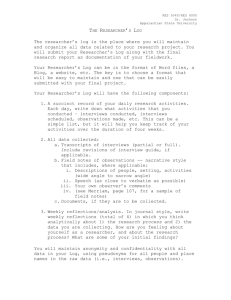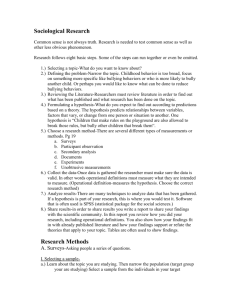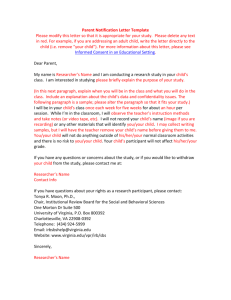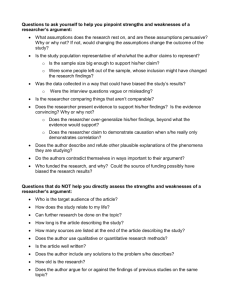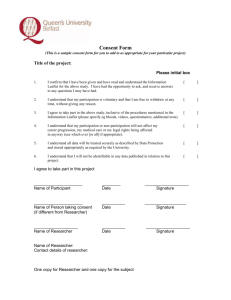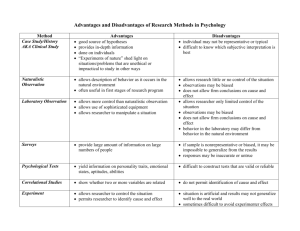chapter 5 how sociologists do research
advertisement
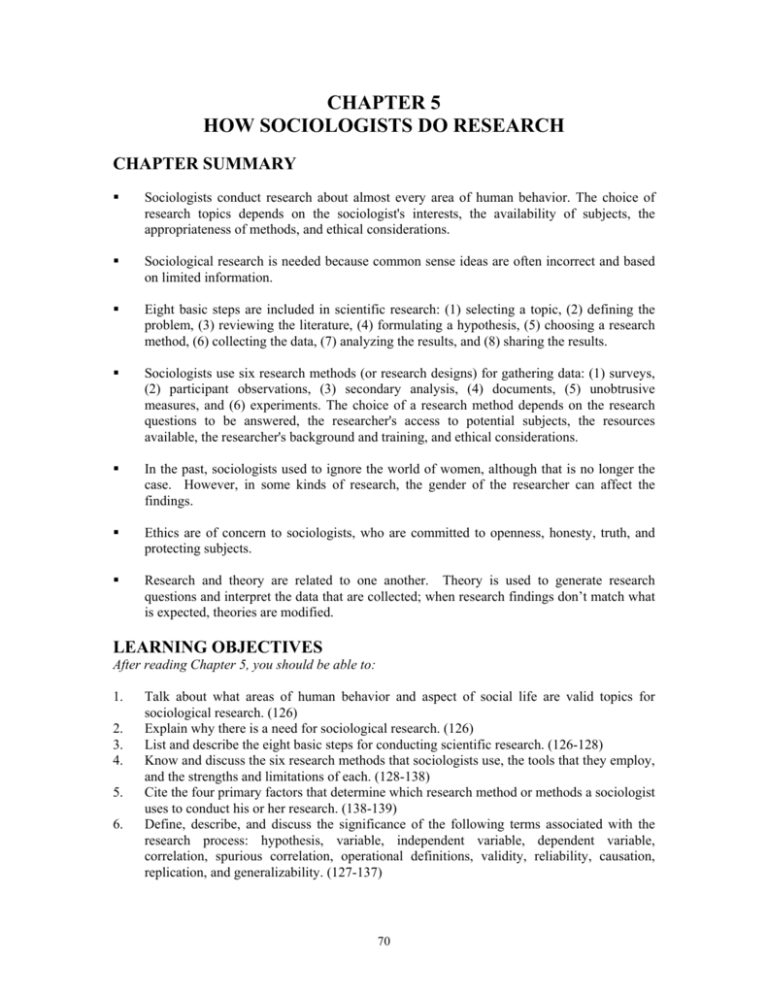
CHAPTER 5 HOW SOCIOLOGISTS DO RESEARCH CHAPTER SUMMARY Sociologists conduct research about almost every area of human behavior. The choice of research topics depends on the sociologist's interests, the availability of subjects, the appropriateness of methods, and ethical considerations. Sociological research is needed because common sense ideas are often incorrect and based on limited information. Eight basic steps are included in scientific research: (1) selecting a topic, (2) defining the problem, (3) reviewing the literature, (4) formulating a hypothesis, (5) choosing a research method, (6) collecting the data, (7) analyzing the results, and (8) sharing the results. Sociologists use six research methods (or research designs) for gathering data: (1) surveys, (2) participant observations, (3) secondary analysis, (4) documents, (5) unobtrusive measures, and (6) experiments. The choice of a research method depends on the research questions to be answered, the researcher's access to potential subjects, the resources available, the researcher's background and training, and ethical considerations. In the past, sociologists used to ignore the world of women, although that is no longer the case. However, in some kinds of research, the gender of the researcher can affect the findings. Ethics are of concern to sociologists, who are committed to openness, honesty, truth, and protecting subjects. Research and theory are related to one another. Theory is used to generate research questions and interpret the data that are collected; when research findings don’t match what is expected, theories are modified. LEARNING OBJECTIVES After reading Chapter 5, you should be able to: 1. 2. 3. 4. 5. 6. Talk about what areas of human behavior and aspect of social life are valid topics for sociological research. (126) Explain why there is a need for sociological research. (126) List and describe the eight basic steps for conducting scientific research. (126-128) Know and discuss the six research methods that sociologists use, the tools that they employ, and the strengths and limitations of each. (128-138) Cite the four primary factors that determine which research method or methods a sociologist uses to conduct his or her research. (138-139) Define, describe, and discuss the significance of the following terms associated with the research process: hypothesis, variable, independent variable, dependent variable, correlation, spurious correlation, operational definitions, validity, reliability, causation, replication, and generalizability. (127-137) 70 HOW SOCIOLOGISTS DO RESEARCH 7. 8. 9. 10. 11. 12. Define, describe, and discuss the significance of the following terms associated with the six research methods: survey, population, sample, random sample, stratified random sample, questionnaires, self-administered questionnaires, interview, interviewer bias, structured interviews, closed-ended questions, unstructured interviews, open-ended questions, rapport, participant observation, secondary analysis, documents, unobtrusive measures, experiment, experimental group, and control group. (128-137) Understand the Hawthorne effect and talk about its significance. (138) Distinguish between quantitative and qualitative research methods. (138-139) Discuss the role that gender can and often does play in sociological research. (141) Know the ethical guidelines that sociologists are expected to follow and talk about the ethical issues raised in Mario Brajuha’s and Laud Humphrey’s research. (142-143) Discuss how and why research and theory need to work together in order to fully explore and understand human behavior. (143-144) CHAPTER OUTLINE I. What is a Valid Sociological Topic? A. Sociologists research just about every area of human behavior at both the macro and micro levels. B. No human behavior is ineligible for research, whether it is routine or unusual, respectable or reprehensible. II. Common Sense and the Need for Sociological Research A. Common sense cannot be relied on as a source of knowledge because it is often limited and based on limited information. B. To move beyond common sense and understand what is really going on, it is necessary to do sociological research. III. A Research Model A. Selecting a topic is guided by sociological curiosity, interest in a particular topic, research funding from governmental or private source, and pressing social issues. B. Defining the problem involves specifying what the researcher wants to learn about the topic. C. Reviewing the literature uncovers existing knowledge about the problem, helps narrow down the problem and learn what areas need to be researched, and provides ideas about what questions to ask. D. Formulating a hypothesis involves stating the expected relationship between variables, based on predictions from a theory. Hypotheses need operational definitions, or precise ways to measure the variables. E. Choosing a research method is influenced by the research topic and the questions that need to be answered. F. Collecting the data involves concerns over validity, the extent to which operational definitions measure what was intended, and reliability, the extent to which data produce consistent results. Inadequate operational definitions and sampling hurt reliability. G. Analyzing the results involves the use of either qualitative or quantitative techniques to analyze data. Computers have become powerful tools in data analysis because they reduce large amounts of data to basic patterns, take the drudgery out of analyzing data, allow the researcher to use a variety of statistical tests, and give the researcher more time to interpret the results. 71 CHAPTER 5 H. By writing up and publishing the results, the findings are available for replication. That is, others can repeat your study to see if they come up with similar findings. IV. Research Methods A. Surveys involve collecting data by having people answer a series of questions. 1. The first step is to determine a population (the target group to be studied) and select a sample (individuals from within the target population who are intended to represent the population to be studied). Random samples are those where everyone in the target population has the same chance of being included in the study. A stratified random sample is a sample of specific subgroups (e.g. freshmen, sophomores, juniors) of the target population (a college or university) in which everyone in the subgroup has an equal chance of being included in the study. 2. The respondents (people who respond to a survey) must be allowed to express their own ideas so that the findings will not be biased. 3. The questionnaires can be administered either by asking respondents to complete the survey themselves (self-administered questionnaires) or by asking respondents the questions directly (interviews). The researcher must consider the effects that interviewers have on respondents that lead to biased answers (interviewer bias) and whether to make the questions structured (closed-ended questions in which the answers are provided) or unstructured (open-ended questions which people answer in their own words). 4. It is important to establish rapport, or a feeling of trust between researchers and subjects. B. In participant observation, the researcher participates in a research setting while observing what happens in that setting. 1. Generalizability, which is the extent to which the findings from one group (or sample) can be generalized or applied to other groups (or populations), is a problem in participant observation studies. 2. Results of participant observation studies can stimulate hypotheses and theories that can be tested in other settings, using other research methods. C. Secondary analysis, which is the analysis of data already collected by other researchers, is used when resources are limited and/or existing data may provide excellent sources of information. However, because the researcher did not directly carry out the research, he or she cannot be sure that the data were systematically gathered, accurately recorded, and biases avoided. D. Documents, or written sources, may be obtained from many sources, including books, newspapers, police reports, and records kept by various organizations. E. Unobtrusive measures involve observing social behavior of people who do not know they are being studied. F. Experiments are especially useful in determining causal relationships. 1. Experiments involve independent (factors that cause a change in something) and dependent variables (factors that are changed). 2. Experiments require an experimental group (subjects exposed to the independent variable) and a control group (subjects not exposed to the independent variable). G. Deciding which method to use involves four primary factors. 1. The researcher must consider resources like time and available money. 2. Access to subjects is important; the sample may be physically inaccessible to researcher, thereby influencing the choice of methods. 72 HOW SOCIOLOGISTS DO RESEARCH 3. 4. V. The researcher takes into consideration the purpose of the research, choosing the method that will be most suitable for obtaining answers to the questions posed. The researcher's background or training also influences the choice of methods. Those trained in use of quantitative research methods (emphasis is placed on precise measurement and the use of statistics and numbers) are likely to choose surveys, while those trained in use of qualitative research methods (emphasis is placed on describing and interpreting people's behavior) lean toward participant observation. Gender in Sociological Research A. Because gender can be a significant factor in social research, researchers take steps to prevent it from biasing their findings. B. Gender can also be an obstacle to doing research, particularly when the gender of the researcher is different from that of the research subjects and the topic under investigation is a sensitive one. C. There are also questions regarding the degree to which findings from a sample made up exclusively of one gender can be generalized to the other. VI. Ethics in Sociological Research A. Ethics are of fundamental concern to sociologists when it comes to doing research. B. Ethical considerations include being open, honest, and truthful; not harming the subject in the course of conducting the research; protecting the anonymity of the research subjects; and not misrepresenting themselves to the research subjects. C. The Brajuha research demonstrates the lengths sociologists will go to in order to protect the anonymity of research subjects, while the Humphreys research illustrates questionable research ethics. VII. How Research and Theory Work Together A. Sociologists combine research and theory in different ways. Theory is used to interpret data (i.e. functionalism, symbolic interaction and conflict theory provide frameworks for interpreting research findings) and to generate research. Research helps to generate theory. B. Real life situations often force researchers to conduct research in ways that fall short of the ideal. KEY TERMS After studying the chapter, review the definition for each of the following terms. closed-ended questions: questions followed by a list of possible answers to be selected by the respondent (133) control group: the group of subjects not exposed to the independent variable in the study (135) dependent variable: a factor that is changed by an independent variable (137) documents: in its narrow sense, written sources that provide data; in its extended sense, archival material of any sort, including photographs, movies, CD’s, DVD’s, and so on (135) experiment: the use of control groups and experimental groups and dependent and independent variables to test causation (135) experimental group: the group of subjects exposed to the independent variable in a study (135) generalizability: the extent to which the findings from one group (or sample) can be generalized or applied to other groups (or populations) (134) 73 CHAPTER 5 hypothesis: a statement of the expected relationship between variables according to predictions from a theory (127) independent variable: a factor that causes a change in another variable, called the dependent variable (137) interview: direct questioning of respondents (133) interviewer bias: effects that interviewers have on respondents that lead to biased answers (133) open-ended questions: questions that respondents are able to answer in their own words (133) operational definition: the way in which a variable in a hypothesis is measured (127) participant observation (or fieldwork): research in which the researcher participates in a research setting while observing what is happening in that setting (133) population: the target group to be studied (129) qualitative research method: research in which the emphasis is placed on observing, describing and interpreting people's behavior (138) quantitative research method: research in which the emphasis is placed on precise measurement, the use of statistics and numbers (138) questionnaires: a list of questions to be asked (131) random sample: a sample in which everyone in the target population has the same chance of being included in the study (130) rapport: a feeling of trust between researchers and the subjects that they are studying (133) reliability: the extent to which data produce consistent or dependable results (128) replication: repeating a study in order to test its findings (128) research method (or research design): one of six procedures sociologists used to collect data: surveys, participant observation, secondary analysis, documents, unobtrusive measures, and experiments (127) respondents: the people who respond to a survey, either in interviews or self-administered questionnaires (131) sample: the individuals intended to represent the population to be studied (130) secondary analysis: the analysis of data already collected by other researchers (134) self-administered questionnaire: questionnaires filled out by respondents (131) stratified random sample: a sample from select subgroups of the target population in which everyone in these subgroups has an equal chance of being included in the research study (131) structured interviews: interviews that use closed-ended questions (133) survey: the collection of data by having people answer a series of questions (128) unobtrusive measures: the various ways of observing people who do not know they are being studied (137) unstructured interviews: interviews that use open-ended questions (133) validity: the extent to which an operational definition measures what it was intended to measure (127) variable: a factor thought to be significant for human behavior, which varies or changes from one case to another (127) 74 HOW SOCIOLOGISTS DO RESEARCH KEY PEOPLE Review the major theoretical contributions or findings of these people. Chloe Bird and Patricia Rieker: These sociologists caution against assuming that research findings that apply to one gender apply to the other. Because women’s and men’s lives differ significantly, doing research on only one half of humanity will lead to incomplete research. (141) Mario Brajuha: During an investigation into a restaurant fire, officials subpoenaed notes taken by this sociologist in connection with his research on restaurant work. He was threatened with jail. (142) Laud Humphreys: This sociologist carried out doctoral research on homosexual activity but ran into problems when he misrepresented himself to his research subjects. Although he earned his doctorate degree, he was fired from his position because of his questionable ethics. (142143) Elton Mayo: Mayo is famous for his research at the Western Electric Company Hawthorne plant during the 1920s. He found that workers' productivity changed in directions that had not been originally hypothesized. He concluded that workers adjusted their productivity because they knew they were being observed. This phenomenon came to be known as the Hawthorne effect. (138) C. Wright Mills: Mills argued that research without theory is of little value, simply a collection of unrelated "facts," and theory that is unconnected to research is abstract and empty, unlikely to represent the way life really is. (143) Peter Rossi: Rossi produced a controversial piece of research related to counting of the homeless, which revealed that the average number of homeless on any given night was far less than homeless advocates had been stating. (140) Diana Scully and Joseph Marolla: These two sociologists interviewed convicted rapists in prison and found that rapists are not sick or overwhelmed by uncontrollable urges but rather men who have learned to view rape as appropriate in various circumstances. (143-144) STUDENT APPLICATION PROJECTS This is your opportunity to apply the sociological perspective to the world around you. The projects in this section refer to material introduced in this chapter of your text. These projects help you to apply the sociological perspective “down to earth…down to your daily life.” 1. Think back to the last time you participated in a survey (phone, web, or mail). Did you really want to participate in the survey? Why or Why not? What problems did you notice with the survey? Do you think most people are compelled to give socially acceptable answers in survey? Explain. Finally, discuss to what extent you think surveys are a good way to do research. 2. If you were a researcher, identify a couple of settings in which you could use the participant observation method. What would be the positives in using this method and what concerns might you have in using such a method? 3. Why is marketing research controversial in sociology? Explain. What are the pros and cons of marketing research? What do you think about marketing research? 75 CHAPTER 5 SELF-TEST MULTIPLE CHOICE QUESTIONS 1. A researcher doing a macro level study would choose __________ as a topic. (126) a. waiting in public places b. race relations c. interactions between people on street corners d. meat packers at work 2. Sociologists believe that research is necessary because: (126) a. common sense ideas may or may not be true. b. they want to move beyond guesswork. c. researchers want to know what really is going on. d. All of the above. 3. __________ steps are involved in scientific research. (126) a. four b. six c. eight d. ten 4. Which of the following is not a reason why researchers review the literature? (127) a. to help them narrow down the problem by pinpointing particular areas to examine. b. to develop ideas about how to do their own research. c. to insure that their research findings will confirm their hypotheses. d. to determine whether the problem has been answered already. 5. A relationship between or among variables is predicted: (127) a. by a hypothesis. b. by use of operational definitions. c. when the researcher selects the topic to be studied. d. when the researcher is analyzing the results. 6. Why is validity important in the research process? (127) a. because the researcher wants to make sure his research will be published. b. because the researcher wants to be sure that his operational definitions are really measuring what they are intended to measure. c. because the researcher is ethically bound to produce valid results. d. because validity is what distinguishes scientific research from common sense. 7. Reliability refers to: (128) a. the extent to which operational definitions measure what they are intended to measure. b. the extent to which data produce consistent results from one study to the next. c. the integrity of the researcher. d. the ways in which the variables in a hypothesis are measured. 8. In analyzing data gathered by participant observation, a researcher is likely to choose: (128) a. computer analysis. 76 HOW SOCIOLOGISTS DO RESEARCH b. c. d. quantitative analysis. qualitative analysis. statistical analysis. 9. Why are computers valuable in quantitative analysis? (128) a. sociologists can analyze huge amounts of information and identify basic patterns. b. computer software programs take much of the drudgery out of data analysis. c. researchers can try various statistical tests to see which prove the most valuable for analyzing their data. d. all of the above. 10. Replication: (128) a. is the extent to which operational definitions measure what was intended. b. is the examination of a source to identify its themes. c. is the repetition of research by others in order to test its findings. d. is copying the work of some other researcher. 11. Based on Table 5.2 in your text, all of the following are ways to measure "average" except: (130) a. medial. b. mean. c. median. d. mode. 12. Which of the following is not a method for gathering data? (128-138) a. ethnomethodology. b. surveys. c. unobtrusive measures. d. secondary analysis. 13. A sample is defined as: (130) a. people available to be studied. b. a partial representation of the target group. c. the individuals intended to represent the population to be studied. d. specific subgroups of the population who have volunteered to participate. 14. You have decided to compare the experiences of freshmen and seniors. You identify students in the two classes you are interested in studying, and then you select a certain number from each group, making sure that each person has an equal chance of being selected. Which of the following sampling methods have you used? (131) a. target sampling random sampling b. c. stratified random sampling d. random subsampling 15. Sometimes when a researcher is asking questions to a respondent face-to-face or over the telephone, the person may feel compelled to give “socially acceptable” answers. This outcome is due to: (133) a. asking open-ended questions. 77 CHAPTER 5 b. c. d. Rapport between the respondent and researcher. interviewer bias. interviewee bias. 16. Why might a researcher "load the dice" in designing a research project? (132) a. The researcher doesn't know any better. b. The researcher may have a vested interest in the outcome of the research. c. The researcher is short on time and money but still wants to get the desired results. d. All of the above. 17. You have been hired to do a survey of a community's views on a proposed anti-crime program. With only a small budget, you need to contact at least 70 percent of the residents living in the affected areas within the next month. Which method are you most likely to choose? (131-133) a. participant observation b. self-administered questionnaires c. interviews d. structured interviews 18. The advantage of structured interviews is that: (133) a. they use open-ended questions to get in-depth responses. b. they are faster to administer and make it easier for answers to be coded. c. they make it possible to test hypotheses about cause and effect relationships. d. none of the above. 19. Problems that must be dealt with in conducting participant observation include: (133-134) a. the researcher's personal characteristics. b. developing rapport with respondents. c. generalizability. d. all of the above. 20. The analysis of data already collected by other researchers is referred to as: (134) a. surveying the literature. b. use of documents. c. secondary analysis. d. replication. 21. Sources such as newspapers, diaries, bank records, police reports, household accounts, and immigration files are all considered: (135) a. unreliable data sources. b. documents that provide useful information for investigating social life. c. useful for doing quantitative research but not valid when doing qualitative analysis. of limited validity because it would be difficult to replicate the study. d. 22. To study patterns of alcohol consumption in different neighborhoods, you decide to go through the recycling bins and count the beer, wine, and liquor bottles. You would be using: (137) a. participant observation. b. experimental methods. c. unobtrusive methods. 78 HOW SOCIOLOGISTS DO RESEARCH d. qualitative methods. 23. Which method will a researcher use if he or she is interested in determining causal relationships? (135) a. an experiment b. survey research c. participant observation d. none of the above. 24. In an experiment, the group not exposed to the independent variable in the study is: (135) a. the guinea pig group. b. the control group. c. the experimental group. d. the maintenance group. 25. The change in behavior that occurs when subjects know they are being studied is: (138) a. the Hawthorne effect. b. the Humphreys effect. c. the unobtrusive effect. d. the obtrusive effect. 26. When you analyze your data you find that men who abuse women are often drunk at the time the abuse takes place. How do sociologists refer to the simultaneous presence of both alcohol and abuse? (136) a. simulation b. correlation c. association d. intervening variable 27. Surveys are more likely to be used by researchers trained in: (138) a. social psychology. b. ethnomethodology. c. quantitative research methods. d. qualitative research methods. 28. Why is it important to consider gender in planning and conducting research? (141) a. the gender of the interviewer might produce interviewer bias. b. it cannot be assumed that men and women experiences the social work in the same way, so both need to be studied in order to have a complete picture. c. gender is a significant factor in social life. all of the above. d. 79 CHAPTER 5 29. Research ethics require: (141-142) a. openness. b. that a researcher not falsify results or plagiarize someone else's work. c. that research subjects should not be harmed by the research. d. all of the above. 30. Which of the following statements best describes the relationship between theory and research? (143-144) a. research is really more important than theory, since it is research that proves or disproves common sense. b. research and theory are both important, since research without theory is simply facts and theory without research is abstract and empty. c. theory is really more important than research, since it is theory that provides the explanations for why people do what they do. d. research should always follow theory, since theory is more important to sociology than research. TRUE-FALSE QUESTIONS 1. _____Date rape is an acceptable topic for sociological research. (126) 2. _____After selecting a topic, the next step in the research model is defining the problem. (127) 3. _____An operational definition refers to the precise ways in which researchers measure their variables. (127) 4. _____In general, researchers give higher priority to reliability than validity. (127-128) 5. _____Reliability is the extent to which data produce consistent results. (128) 6. _____Validity is important in order to test the findings from a study. (128) 7. _____Computers are valuable to research sociologists because they can store a great deal of information very efficiently. (128) 8. _____One of the first steps in conducting survey research is to determine a population. (129) 9. _____In survey research, it is undesirable for respondents to express their own opinions. (131) 10. _____The wording of questionnaires can affect research results. (133) 11. _____Structured interviews always use closed-ended questions. (133) 12. _____Establishing rapport is extremely important in participant observation. (133-134) 13. _____Secondary analysis and use of documents mean the same thing in terms of research methods. (134-135) 14. _____It is always unethical to observe social behavior in people when they do not know they are being studied. (137-138) 15. _____The purpose of an experiment is to identify causal relationships. (135) 16. _____Before a researcher can conclude that a cause-effect relationship exists, it is necessary to rule out possible spurious corrections. (136) 17. _____Quantitative research methods emphasize precise measurement, the use of statistics and numbers. (138) 18. _____Research done on one gender can be applied to the other gender. (141) 19. _____Research conducted by sociologists must meet professional ethical criteria. (141-142) 20. _____The research by Scully and Marolla demonstrate that research must be done under ideal conditions in order for the findings to be valid. (143-144) 80 HOW SOCIOLOGISTS DO RESEARCH FILL-IN-THE-BLANK QUESTIONS 1. 2. 3. 4. 5. 6. 7. 8. 9. 10. 11. 12. 13. 14. 15. A statement about the relationship between variables according to predictions from a theory is known as a _____________. (127) After you gather data, it is time to ___________________ them. (128) The __________is the target group you intend to study. (129) There are _______________ways to measure the average. (130) The best sample is a ___________sample. (130) A survey researcher needs to make sure questions are __________. (131) In order to research topics like domestic violence, it is important that the researcher establish ______________with respondents. (133) A sociologists who is studying the trash left behind in garbage cans, is most likely engaging in the ___________________________ method. (137) The __________ variable causes a change in another variable. (175) Sociologists trained in quantitative research methods are most likely to use the __________ method. (138) Peter Rossi and his associates attempted to count the _________________ in Chicago. (140) Sometimes in research, one’s gender can lead to __________________________ bias. (141) ____________ disguised himself and mislead his subjects while conducting research. (142) C. Wright Mills argued that you cannot have research without __________________. (143) Systematic research and the application of theory take us beyond ________________. (144) MATCH THESE CONCEPTS WITH THEIR DEFINITIONS _____ 1. Hawthorne effect _____ 2. population _____ 3. control group _____ _____ _____ _____ 4. 5. 6. 7. _____ 8. independent variable _____ 9. operational definition _____ 10. unobtrusive measures interviewer bias replication secondary analysis documents a. observation of people who don’t know they are being studied b. behavior change due to subject's awareness of being studied c. the interviewer’s effect on respondents that leads to biased answers d. the way in which a researcher measures a variable e. written sources f. the target group to be studied g. the analysis of data already collected by other researchers h. the group of subjects who are exposed to the independent variable i. repeating a study to see if the same results are obtained j. a factor that causes a change in another variable 81 CHAPTER 5 ESSAY QUESTIONS 1. Choose a topic and explain how you would go through the different steps in the research model. 2. Discuss some of the things that can go wrong in the process of doing research and provide suggestions on how to overcome such problems. 3. The author of your text discusses six different research methods. Pick a research topic of interest to you and discuss how you might try to investigate this topic using these different methods. In your answer, consider how a particular method may or may not be suitable for the topic under consideration. 4. Explain why ethical guidelines are necessary when conducting social science research. 5. Discuss the relationship between theory and research and why commonsense is not enough. 82


